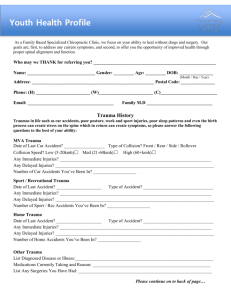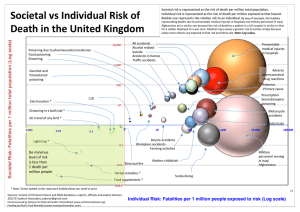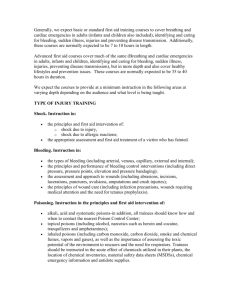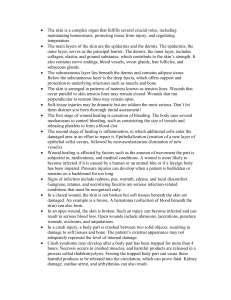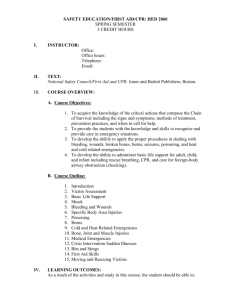INTRODUCTION LEARNING OBJECTIVES
advertisement
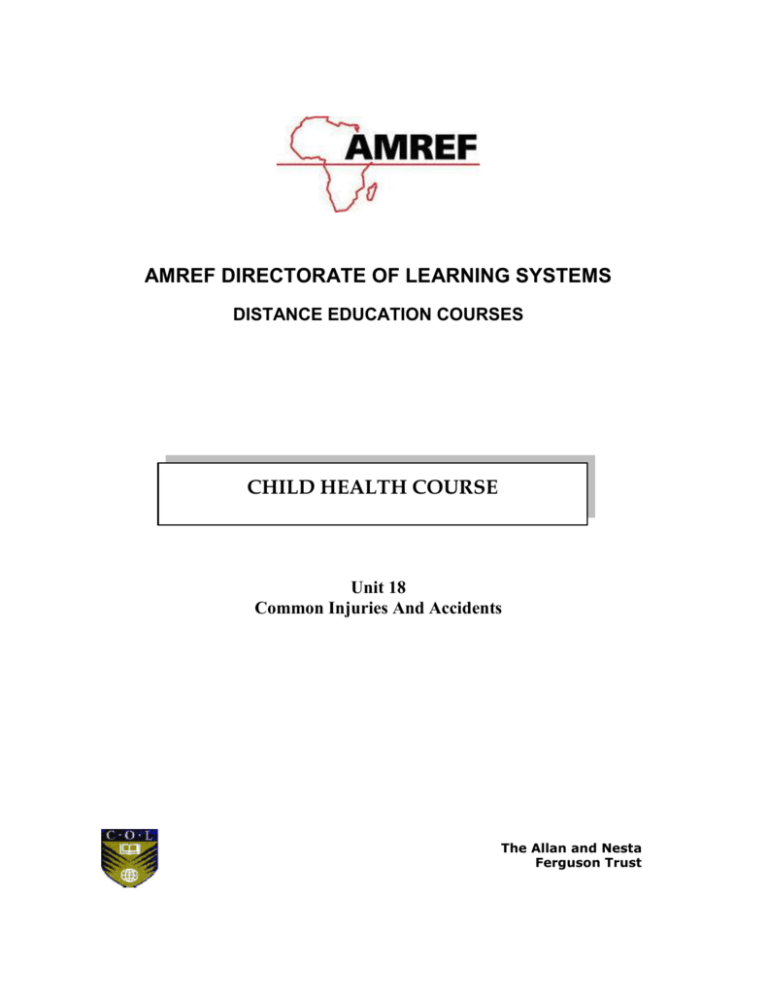
AMREF DIRECTORATE OF LEARNING SYSTEMS DISTANCE EDUCATION COURSES CHILD HEALTH COURSE Unit 18 Common Injuries And Accidents The Allan and Nesta Ferguson Trust UNIT 18: COMMON INJURIES AND ACCIDENTS A distance learning course of the Directorate of Learning Systems (AMREF) © 2007 African Medical Research Foundation (AMREF) This work is distributed under the Creative Common Attribution-Share Alike 3.0 license. Any part of this unit including the illustrations may be copied, reproduced or adapted to meet the needs of local health workers, for teaching purposes, provided proper citation is accorded AMREF. If you alter, transform, or build upon this work, you may distribute the resulting work only under the same, similar or a compatible license. AMREF would be grateful to learn how you are using this course and welcomes constructive comments and suggestions. The African Medical and Research Foundation (AMREF) Directorate of Learning Systems P O Box 27691 – 00506, Nairobi, Kenya Tel: +254 (20) 6993000 Fax: +254 (20) 609518 Email: amreftraining@amrefhq.org Website: www.amref.org Writer: Prof. Nimrod Bwibo Cover Design: Bruce Kynes Technical Co-ordinator: Joan Mutero The African Medical Research Foundation (AMREF wishes to acknowledge the contributions of the Commonwealth of Learning (COL) and the Allan and Nesta Ferguson Trust whose financial assistance made the development of this course possible. 2 UNIT 18: COMMON INJURIES AND ACCIDENTS INTRODUCTION: Accidents and injuries are common, especially among young children aged 1 – 4 years of age. Accidents are happening that are usually unintended and unforeseen. It is therefore important that you, the health workers, are aware of these possible unpleasant and unintended happenings and should play a big role first in the prevention and secondly in their management. We shall discuss both accidental and Non-accidental injuries. LEARNING OBJECTIVES: By the end of this unit, you should be able to: Define the term accident. List the predisposing factors that cause accidents. List common accident in your catchment area. Describe fractures, wounds, bites and stings, burns and scalds, poisoning and drowning. Explain procedures for managing the common types of accidents. Explain how to prevent the most common accidents. Explain what road traffic accidents are and how to prevent them. Outline the management and prevention of rape. 18.1 DEFINING THE TERM ACCIDENT What do you understand by the term accident? An accident is a happening that is not intended, foreseen or expected that can cause an injury and sometimes death. Accidents sometimes result from negligence. ACTIVITY What are the most common types of accidents in your area? _____________________________________________________________________ _____________________________________________________________________ _____________________________________________________________________ _____________________________________________________________________ _____________________________________________________________________ 1 Compare your list with some of the common accidents that have been listed: Falls Cuts Burns and scales Bites and stings Poisoning Inhalation of foreign bodies. Road traffic accidents Drowning Non Accidental injuries (Child Abuse) and sexual abuse are on, the increase 18.2 PREDISPOSING FACTORS TO ACCIDENTS Predisposing factors to the causation of accidents are of two types: Environmental factors and Childhood factors. We shall give the main factors in each category of accidents described in the text. (i) Environmental Factors. They are things in the child’s environment at home and outdoor that may predispose or lead the child to get an accident. For example; poorly arranged furniture in the house can make a child fall and injure himself or herself, unprotected cooking place can lead to child burns. Fruit trees or ladders in homes may attract a child to climb and result in a fall. Similarly pools of water outdoor including unfilled quarry with accumulation of water may lead to drowning. A final example is the overcrowded city slums are particularly bad environment for children. (ii) Childhood Factors: These are factors centred on the child. They include The normal curiosity, exploration nature and imitation of a child, a child still learning and has no experience that can land them into accidents. Boys are more explorative and get into accidents more frequently than girls. But girls are more affected by accidents in cooking place at home than boys. Abnormal factors in a child that can lead into accidents include: a child with epilepsy, a child with a handicap. 18.3 BURNS AND SCALDS: Burns are injuries on the body caused by dry heat, while scalds are injuries on the body caused by moist heat. Small children are often burned or scaled since they often play close to fires and cooking pots and have not yet learned wisdom through experience. Remember the saying that once bitten twice shy. 2 Dry heat can be caused by any of the following: Burning house. Fire or hot objects or exposure to sun. Contact with an electric current or by lighting. Friction from a revolving wheel or fast moving rope. Strong acids and alkalis such as sulphuric acid or caustic soda. Moist heat can come from boiling hot water, such as tea, porridge or steam. If the burn is wide spread it can cause systemic complications. For example: Large amounts of fluid are lost from the burned surface causing shock. Pain can also contribute to state of shock. Anaemia is caused by blood loss and other causes. Secondary infection can also occur. Later on unsightly scars on the face or contractures of limbs may occur during healing. ACTIVITY Who are the children most at risk of getting burns? _____________________________________________________________________ _____________________________________________________________________ _____________________________________________________________________ _____________________________________________________________________ _____________________________________________________________________ What have you written? Compare your list with the following: Young Children Epileptic Children Children with handicaps Types of Burns: There are two main types of burns: Superficial burns: Here there is only partial skin loss. This usually heals by the epidermis growing from the burnt edges. Deep burns: When the whole skin and deep structures have been burned. Deep burns are serious. 3 Signs and Symptoms: Pain. This is the main symptom of burns. Redding of the skin in brown skinned persons or darkening of the skin in dark skinned persons. Blisters: This is when the burned areas forms small bubbles, like raised skin filled with fluid. Exposure of raw or charred flesh: This is when the deeper tissues of the body, like muscles, blood vessels or even bones, get burned. These are deep burns The severity of burns depends upon the extent of body surface area burnt and also how deep the resulting injuries are. Figure 18.1 shows the area of burns as a percentage of body surface. Figure 18.1: Area of burns as a percentage of the body surface Management: Examine the patient for shock. A patient in shock has cold nose and fingers. Feel for a thready pulse and find out if the blood pressure is low. If the patient is in shock, refer 4 him/her to hospital for IV fluids. If he/she can still take fluids orally, encourage him/her to take plenty of oral rehydration solution. Assess the extent of the burn. Find out how much of the body surface has been burned. Use the rule of 7 for children. Treat for shock including giving intravenous fluids and pain relief. Given a pain killer such as paracetamol, asprin or brufen. Stop bleeding if there is a bleeding site, by applying a firm dressing at the point of bleeding. Bleeding may need a transfusion of blood or saline to prevent shock. Bleeding from an open wound needs a pressure bandage or a firm dressing at the point of bleeding. Put up an intravenous drip on any patient who has lost blood before you send him/her to hospital. It may make the difference between life and death. Encourage the patient to take fluids if he/she is conscious. The patient will require blood transfusion at the hospital Give tetanus toxoid to prevent tetanus. Note: Damage to nerves and major blood vessels need urgent transfer to hospital. Prevention: Prevention of burns in children focuses on child supervision and protection of the cooking place. Caretakers should be particularly careful when there are hot liquids, tea, porridge or soup in the environment of the child. Children should not play with fire or box of matches. 18.4 FRACTURES, SPRAINS AND DISLOCATIONS: ACTIVITY What is a fracture? _____________________________________________________________________ _____________________________________________________________________ _____________________________________________________________________ _____________________________________________________________________ _____________________________________________________________________ 5 Compare your answer with the one below: A fracture is a break in the continuity of bone. It may be complete or incomplete. The causes of fractures are: 1. Direct force: This is when the bone breaks when direct force is applied, for example from a kick or blow. 2. Indirect force: This is when the bone breaks some distance from the spot where the force is applied. ACTIVITY How do you classify fracture? _____________________________________________________________________ _____________________________________________________________________ _____________________________________________________________________ _____________________________________________________________________ _____________________________________________________________________ Compare your answers with the classification below. There are two main classifications of fractures: 1. Closed fractures: This is where the over lying skin is not broken. 2. Open fractures: This is when the over lying skin is broken. The broken bones can easily be seen through the broken skin. ACTIVITY What are signs and symptoms of fractures? _____________________________________________________________________ _____________________________________________________________________ _____________________________________________________________________ _____________________________________________________________________ _____________________________________________________________________ 6 Signs and Symptoms: These may include: Pain, which may be severe. Tenderness on touch. Failure to use the affected part of the body. Swelling of the affected part. Bleeding in an open fracture. Deformity, such as irregularity of the bone, shortening of the limb, depression of flat bone. Angulation or rotation of the bone. Management: It is important to take a proper history because this will influence your treatment of the fracture. For example, if you learned that the fracture happened several weeks ago, you will realize that the reduction will be difficult. It is also important to carry out thorough examination. There are three steps in examining a fracture: 1) LOOK: Observe the injured part carefully. Bear in mind the normal appearance of the affected part so that you recognize any abnormalities. For example, look for flexion, rotation, adduction and shortening. 2) FEEL: Always be gentle, especially with children. If you hurt your patient at the beginning of the examination, the child will not readily co-operate. If there are areas of tenderness, note exactly where they lie. If they are over a bone, then a fracture is likely. Another sign to look for is crepitus. This is a grinding sensation as the splintered ends of the bone rub together. This test is unnecessary and cruel. Palpation is also useful in telling whether bones have been displaced. 3) MOVE: Get your patient to try to move the affected part. If he/she can do this normally get him/her to use it. Often this is the point when it becomes obvious that something is wrong. 4) XRAY: In theory, every fracture should be X-rayed. However, this is not always possible. Certain fractures can always be managed satisfactorily without x-ray. Treatment: In treating a fracture you should do the following: Immobilize the affected part with a splint. An emergency splint is important to prevent pain and shock, especially if your patient has to be transferred a long way to hospital. In splinting a leg you can: Tie it to the other leg Use sticks Use pillows 7 Splintage until union: In general, it is necessary to have splintage until union, or until bones have healed. For displaced fractures, reduction is required and then splintage. For non-displaced fractures that are stable, no splintage is required. Prescribe rest and protection. For non-displaced fractures that are unstable, splintage is required until union. For all fractures you must encourage muscle activity whether they are splinted or not. Protection until splintage: Protection is still necessary when the bone is united but not fully consolated. A fracture should still be protected, for example by use of crutches or by not bearing weigh on it or, in case of broken ulna and radius they should be kept in a plaster of paris cast. 18.5 POISONING Children commonly drink poisonous substances or drugs left in their reach. The more attractive the colours of a substance or drug, the higher the risk of the substance being taken and ingested by a curious, explorative learning children. The effect of the poisoning material depends upon the quantity taken or ingested and the chemical nature of the substance or drug. And also to some extent it also depends on the size or age of the child, nutritional status and whether the stomach is empty as in a hungry child or full with food contents. Large amounts of a poisonous substance are dangerous, while an empty stomach allows easy absorption of the poison while a stomach with food delays absorption of the poisonous substance or drugs. ACTIVITY What are the most common substances that cause accidental poisoning through ingestion? _____________________________________________________________________ _____________________________________________________________________ _____________________________________________________________________ _____________________________________________________________________ _____________________________________________________________________ Compare your list with the one below: Medicines such as aspirin. Household products (paraffin and detergents). Weed killers (like paraquat) Inhalation of organic solvents. Poisonous fruits. Leaves or roots. 8 Signs and Symptoms: Diagnosis is often apparent from the history obtained from the patient, relatives or friends or on circumstantial grounds such as finding tablets near the patient. Be cautious of a situation whereby a little girl may feed her sibling with a poison, but because she is the one caught holding the offending substance, she is treated as if she is the one who has taken it. You should ask the parents exploratory questions if another child is involved so that you do not miss any. Management and Treatment: Treatment for acute poisoning should not be delayed. You should not spend an excessive among of time in attempting to identify precisely the poison involved. The essential immediate management of poisoning is dependent on the application of well-established, basic therapeutic principles. 1. Maintain respiration: A clear airway is essential. Clean vomitus and excess mucous from the mouth. 2. Remove or inactive the poison using activated charcoal. You must remove your patient from the poisonous environment or agent as soon as possible. 3. Emesis or gastric lavage should sometimes be done. Emesis (vomiting) can be induced by mechanical means using a spatula or pushing the fingers at the back of the throat. A decision as to whether emesis (vomiting) or gastric lavage should be undertaken will depend on three factors: a. The substance ingested. b. The state of consciousness of your patient. c. The length of time since the substance was ingested. Do not delay the treatment of poisoning! Every minute counts! 1. Poisoning By Medicine: Poisoning may occur from tablets such as acetylsalicylic acid (ASA), Iron tablets, sulphate, chloroquine or any commonly used medicines. Young children are more susceptible to the toxic effects of salicylates than adults. The signs and symptoms of medicine poisoning are: Drowsiness. Fast breathing. Hyperventilation resulting in respiratory alkalosis and increase in PH of blood. Restlessness, sweating and an increased metabolic rate also occur. Bloody vomitus or diarrhea. Thready pulse and sometimes coma. Tinnitus (deafness) and blurred vision in children. 9 ACTIVITY How should you manage medicine poisoning? _____________________________________________________________________ _____________________________________________________________________ _____________________________________________________________________ _____________________________________________________________________ _____________________________________________________________________ Compare your answers with what is written below: Management and Treatment: In case of medicine poisoning, apply these general measures. Gastric aspiration and lavage should be done in all patients. Increase fluid intake by IV or orally. All patients with suspected poisoning should be retained in hospital for observation for at least 12 hours. Some may stay longer depending on the potency of the poisoning. 2. Kerosene (Paraffin) Poisoning: Kerosene is commonly kept in the house as a fuel for lighting or cooking and may be kept in soda bottles. It is the most common type of accidental poison taken by children. Children often take only mouthfuls or so because of the unpleasant taste. Only small amounts of kerosene can cause poisoning. Never Induce Vomiting For Kerosene Poisoning. ACTIVITY List four signs and symptoms of kerosene poisoning: _____________________________________________________________________ _____________________________________________________________________ _____________________________________________________________________ _____________________________________________________________________ _____________________________________________________________________ 10 Figure 18.2: Dangerous liquids like kerosene should be out of reach of a child Signs and Symptoms: Now read some of the signs and symptoms of kerosene poisoning below: Smell of paraffin in the breath. Cough, Fast respiration or dyspnoea. Drowsiness. Convulsions. Pallor, vomiting and diarrhea. Aspiration into the lungs causing bronchopneumonia. This is the main danger of kerosene poisoning. For this reason, vomiting is dangerous and should never be induced. Acute pulmonary oedema. Coma due to narcotic effects of kerosene. 11 ACTIVITY List four ways of managing a child brought to you with kerosene poisoning: _____________________________________________________________________ _____________________________________________________________________ _____________________________________________________________________ _____________________________________________________________________ _____________________________________________________________________ Management and Treatment: It is important to remember NEVER to induce vomiting with kerosene poisoning. Follow the steps below: Do not make the child vomit. Do not wash out the stomach. Give a big drink of water or milk. Give injectable penicillin. Refer the child urgently to hospital. Note: Causing the child to vomit or gastric washout leads in kerosene fumes being inhaled into the lungs to cause pneumonia. 3. Insecticide Poisoning (Parathion, malathion): Insecticides may be either drunk or absorbed through the skin when used for killing body lice. Signs and Symptoms: Contact with insecticide poisons can cause: Tremors of the muscles. Sweating. Copious secretion of saliva. Pinpoint pupils. The pinpoint or constricted pupil can help you make the diagnosis and guide you in the treatment. In later stages, convulsions, coma and/or paralysis. ACTIVITY What treatment would you give to a child brought to you with insecticide poisoning? _____________________________________________________________________ _____________________________________________________________________ _____________________________________________________________________ _____________________________________________________________________ 12 Compare your answer with mine: Management and Treatment: For a child with insecticide poisoning, you should: 1. Wash the child with soap and water if there has been skin exposure. 2. Give large doses of atropine IM (intramuscularly). In children under five years give 0.5mg and for other children 1mg atropine sulphate every 15-30 minutes until the pupils are wide open. 3. Remember: Refer urgently to hospital. 4. Alcohol Poisoning: Another common poison drunk by children is alcohol including strong home made alcoholic drink changaa. Signs and Symptoms: Smell of alcohol. Weakness. Drowsiness. Sometimes coma. Management and Treatment: 1. In mild cases gives sweetened drinks and observe. 2. In weak, drowsy or comatose children do not give anything. 3. Refer urgently to hospital. The three basic principles for management poisoning can be summarized as: (a) Remove the poison where possible. (b) Neutralize the poison with antidotes. (c) Support the child by giving a drip or oxygen. 18.6 PREVENTION OF POISONING: ACTIVITY List at least four measures that can be taken to prevent poisoning. _____________________________________________________________________ _____________________________________________________________________ _____________________________________________________________________ _____________________________________________________________________ _____________________________________________________________________ 13 Compare your answers with the preventive measures listed below: All drugs should be kept out of reach of children, under lock and key. All unused drugs should be discarded. Adults should not take drugs in front of children. Do not coerce children to take medicine calling it sweets. Kerosene should not be kept in soda bottles, and must be kept out of reach by children. Kerosene containers should be well labeled “kerosene”. Health education to parents on the risks of poisons to children. 18.7: INSECT BITES (PAPULAR URTICARIA) In this section of unit 18, we shall talk about how injuries as a result of insect bites can result into sickness in children. Before we can proceed, I would like to involve you in the following activity: ACTIVITY What are the common biting insects in your area? _____________________________________________________________________ _____________________________________________________________________ _____________________________________________________________________ _____________________________________________________________________ _____________________________________________________________________ Now read through the following discussion and see if your answer is found in here: Bites of various kinds of insects notably mosquitoes, fleas, mites, ticks, lice, bedbugs, wasps, some flies bees, etc. may cause rather severe local or generalized reactions in sensitized individuals. Usually, there is localized oedema with surrounding redness, and frequently intense itching. Secondary infections may occur. It is usually easy to make a diagnosis, since the clinical signs such as headache, swelling, itching, and body rash usually follows an insect bite. In uncomplicated cases, treatment consists of Cleaning the body. Apply calamine lotion locally. Pain killers such as paracetamol to control pain. 14 Antihistamines are only useful systemically, such as promethazine (phenergan) 1mg/kg/day in 3 divided does orally. Do not use antihistamine ointment because this may cause sensitization. In case of severe reactions, for example severe swelling of whole body, passing of dark coloured (or red) urine, or failure to pass urine, please refer the patient to hospital urgently. Give a referral note clearly identifying patient and what happened. 18.8 INHALATION/ ASPIRATION OF FOREIGN BODIES Young children inhale or aspirate foreign bodies in their lungs. Such foreign bodies include; coins, beans and beads. There is chocking at the times of inhalation which is followed by chronic cough due to foreign body being lodged in the lower part of the bronchus. The history of such an event of chocking is classical. The foreign body causes lung problems depending upon the nature of the foreign body. X-ray of the chest can show evidence of the effects of the foreign body. If the inhaled foreign body is metallic, it will show on the x-ray. Management requires early removal of the foreign body 18.9: DROWNING Drowning is when a person dies in the water because he/she is unable to breathe. Most drowning is accidental. Children are especially at risk because they are interested in playing with water; yet do not know to swim. Drowning commonly occurs in swimming pools, rivers, swamps, lakes, water drums at home, and even a bathing basin in case of an infant being bathed. We therefore need to be very careful with bodies of water around our environment. It is best to prevent drowning altogether. We are all responsible. Before we go on, I would like you to do the following activity. ACTIVITY What preventive measures do you think can help reduce the incidence of drowning among children? _____________________________________________________________________ _____________________________________________________________________ _____________________________________________________________________ _____________________________________________________________________ _____________________________________________________________________ Now I would like to welcome you to following discussion. See if your answers are among these: 15 The prevention of drowning can be made possible by: Creating awareness (sensitization) among families, local leaders and the community at large about dangers to children of water ponds and any water collection. Protection of children from bodies of water by fencing, including fencing swimming pools. If children have to go to the bodies of water, they MUST be accompanied by a grown up and preferably one who knows how to swim. Educate children about dangers of water bodies. When faced with a situation of a child near drowning, urgently rescue the child if you know how to swim OR call for help urgently. When the child has been removed from the water, clear the airway, start mouth-to-mouth breathing and urgently refer the patient to hospital. If there is a telephone nearby please call 999 for police or hospital telephone number if you know one. 14.10 ROAD TRAFFIC ACCIDENTS (RTA) Road traffic accidents are accidents that occur among road users. Road traffic accidents are among the most common causes of death in Kenya among children. It is the single most common cause of injury in Kenya. Almost everyday, there is an article in the press about road traffic accidents. Before we can go on, I would like you to do the following activity. ACTIVITY What are the predisposing factors to road traffic accidents in general? _____________________________________________________________________ _____________________________________________________________________ _____________________________________________________________________ _____________________________________________________________________ _____________________________________________________________________ Now read the following discussion and compare with your answer. The predisposing factors to road traffic accidents (RTA) include:- 16 Alcoholism among drivers. Drug ingestion by drivers. Drugs such as Benzodiazepines, antidepressants, antihypertensives, and sedatives antihistamines, have been implicated. Over speeding of motorcycles and bicycles. Over loading of other vehicles, such as cars, taxis, and lorries. Unqualified drivers. Bad roads with pot-holes. Vehicles in poor mechanical conditions. Lack of speed checks on highways. Lack of adequate road traffic tips by the pedestrians. Lack of road safely measures such as zebra crossings. land mines planted on the road in war areas. Mist, heavy smoke and heavy rainfall interfering with visibility. Floods across the road and broken bridges. Slippery roads. PREVENTATION OF ROAD TRAFFIC ACCIDENTS (RTAs) Knowing the causes of RTA’s leads to the measure to prevent them. The following are some practical prevention measures against Road Traffic accidents. Prohibit people from driving under the influence of alcohol and drugs. Educate drivers on medication to cross-check with their physicians whether they can drive or not while on medication. Proper repair of vehicles. Avoid over speeding. Avoid over loading. Reinforce traffic laws, include the use of seat-belts. Improve roads. Give adequate information, education and communication to road safety measure such as speed checks such as bumps and zebra crossings near schools and busy public places, such as market places. Sensitize all the parties concerned about RTA. These include the police, the public, vehicle owners and drivers. 18.11 WOUNDS Wounds are injuries resulting from many types of accidents We would like to discuss wounds that occur as a result of an accident and how to prevent and manage them. 17 A wound is a breakage through the skin surface or mucous membranes. Causes of wounds include: falls, cuts, RTA. There are different types of wounds. First do the following activity. ACTIVITY What are the different types of wound? _____________________________________________________________________ _____________________________________________________________________ _____________________________________________________________________ _____________________________________________________________________ _____________________________________________________________________ Now as you read through the passage and see whether your answers are included. The different types of wounds which occur in accidents such as: Bruises: Wounds where there is bleeding under the skin following trauma. Incised wounds: Wounds with clean-cut edges caused by a sharp knife or glass. Lacerated wounds: These are wounds with ragged edges and are commonly seen in road traffic accidents. They are frequently dirty and contaminated with organic matter. There is an increased risk of infection. Crushed wounds: These wounds are often seen in industrial accidents, severe road accidents and war injuries. Assessment of the wound Wounds associated with accidents in children are common and should be assessed. First take history from mother. This should include: How did the child get the wound? How long ago did the child get the wound? Has the child had active immunization against tetanus. Secondly examine the wound. Look for active bleeding and grade it as slight, moderate or severe bleeding. See the general condition of the patient. Is the patient anaemic, in shock, restless, unconscious, gasping, etc. At this stage you shall be able to make your diagnosis and be able to treat the patient. 18 Treatment of wounds 1. Safe guard the life of patient by removing from the site of accident. For example, if it is a road traffic accident, remove the patient from the road to the side of the road. 2. Take care of the airway especially for wounds involving head, neck and chest. Remove any secretions, blood clots, or soil in the airway. Put the patient in a left lateral position. See if the patient is able to breathe well with the measures above. 3. If the wound is bleeding, stop the bleeding at once by applying a dressing on the wound and then hold it firmly. The best dressing is a pad several layers thick of surgical gauze, sterile if possible. However, when at the site of accident, such pads are usually not available. Under these circumstances, use the patient’s clothing or dress. 4. Any wound that is severely bleeding should be treated in a hospital because it may involve large blood vessels and these may need careful repair by surgeons. So, give first aid, (control bleeding as in (3) above, write a note about the injury that shall serve as a referral note, then refer appropriately. 5. During the transfer/referral process, raise the bleeding part above the chest level. This also reduces the bleeding. 6. If your health facility has all that is needed, then do the following: For severe injuries, give first aid as above and then inform senior most person in the unit so that he/she can manage patient appropriately. If you are most senior person and all equipment is there and you have the qualifications and experience to handle such injuries, then: All clean cut/incised wounds should be sutured if they were sustained less then six hours before. If a wound was sustained over six hours before, or a dirty, contaminated wound then, first do surgical toilet which involves: Painting the whole area with a mild antiseptic live savlon, hibitane in water or a thorough wash with soap and plenty of water. Wipe (clean) the wound with sterile towels. Clean the wound with a knife, cut away a thin strip of the skin edges all around the wound. Cut away any damaged, dirty subcutaneous fat and any dead muscle. Be careful while you do this. Do not cut any vital structures such as nerves, tendons and large vessels. 19 7. You can then decide the method of suturing, either immediately primary suturing or delayed primary suture. 8. Give tetanus toxoid immunization to prevent tetanus infection. 9. Give antibiotics, PPF, once a day for 5 days to treat infections. 10. Give pain killers such as Paracetmol or brufen. Remember to refer the following kinds of wounds to hospital, if you are not in position to handle them. Deep cut wounds Wounds with severe bleeding Wounds in patients who have developed shock Note that whenever you refer any patient with a wound, you should first control the bleeding and give additional first aid, then refer with a referral letter. If you decide to refer your patient, do it early enough!! Prevention of wounds Prevent road traffic accidents as we saw under that section. Do not allow children to play with sharp objects such as blades, knives, etc. Use personal protective equipment such as gloves, shoes, head gear. Create adequate awareness among patients, children and the whole country about wounds. 18.12 NON-ACCIDENTAL INJURIES (NAI) – CHILD ABUSE We cannot conclude the topic of child injuries by describing accidental injuries alone. There is a rising problem of injuries which are caused willfully or intentionally by their own parents or guardians which are referred to as non-accidental injuries and popularly 20 known as child abuse. They are described below to enable you recognize them and manage them effectively a required. Types of injuries These are similar in kind to the accidental injuries. They include; cuts, wounds, burns, scalds, bruises, contusions, fractures, lacerations and scars. They, however, differ from accidental injuries in that they are inflicted deliberately, they are multiple, occur in unusual parts of the body where accidental injuries are unlikely to occur, such as: in perineum, soft palate, tongue or at the back. They are also found in different stages of healing; some fresh, others healing or healed with scar formation. The injuries may even have the appearance and shape indicating the object used to cause them. They may be linear scratches or cuts, circular, teeth bite, shape of buckles or belts. Characteristics of the injuring parents: The father or Mother may be in individual stress, separated, unemployed, but the rich are not excluded. They may be alcoholic or on drugs while others may have psychiatric illness or have no extended family support. Characteristics of the injured children: Children who are difficult to satisfy, crying children, frequently sick children, crippled children, step children are at greatest risk of non-accidental injuries. However even in “normal” looking families children are increasingly being abused by their parents. So its important for you to have a high index of suspicion everytime a child present with the injuries we have just described. The following are alerting signs of non-accidental injuries: The parent delayed to seek medical care for the injuries; The parents give history of the cause of injuries which are hard to believe; The child is frightened or quite subdued in the presence of the offender; The child may be brought by concerned neighbours or relatives. Objects used for Non-Accidental Injuries These include a wide variety of objects, such as fingers nails, teeth, sticks, knives, buckles of belts, hot flat iron, hot liquids; porridge, tea or fire. 21 Management of Non-Accidental injuries (CHILD ABUSE) The wounds and other injuries to be managed as the accidental injuries by surgery However the child should be separated from the offender (abusing) parent during the initial phase of treatment. Nutritional neglect is always seen in the child and should be managed by good diet. Look for hidden injuries by taking x-rays of the bones, skull and the chest referred to as skeletal survey. There is need to take photographs at admission for documentation in case of court proceedings. Arrange for counselling the child and the offender. Report the case to the police and more importantly inform the social worker. 18.13 SEXUAL INJURIES There is increasing sexual abuse of the female child by strangers and even relatives in the form of child rape – sexual assault that leaves the young girl physically and emotionally traumatized. Rape results in severe grades of injuries of female parts in which the sexual parts are severely torn. These heinous acts tend to occur to female children coming from school or coming from late evening shopping. Some children are even raped when left in their houses unsupervised. Apart from the physical injuries the children also ran the risk of getting infected with an STD and HIV/AIDS. Management of such children includes surgical repair of injuries. The affected children should be screened for STD and HIV/AIDS and treated. They also require psychological support in way of counselling. You should refer such children to a facility where they can get this specialized care immediately. Prevention of sexual abuse includes child supervision, reducing hazards and risk situation where the girl-child is walking alone at night or on lonely paths. SUMMARY In this unit we have discussed: What accidents are. Common types of accidents Fractures, cuts, wounds, bites, stings, burns, scalds, poisoning, foreign bodies, and drowning. Accidental injuries. Non-Accidental injuries. This unit also highlighted management and prevention of the common types of accidents. We have now come to the end of the discussion on injuries and accidents. I hope you enjoyed this unit. Take a break and then complete the Tutor Marked Assignment. 22 DIRECTORATE OF LEARNING SYSTEMS DISTANCE EDUCATION COURSES Student Number: ________________________________ Name: _________________________________________ Address: _______________________________________ _______________________________________________ CHILD HEALTH COURSE Tutor Marked Assignment Unit 18: Common Injuries and Accidents and Poisoning 1. List 5 environmental factors which lead to accidental injuries to children. _____________________________________________________________________ _____________________________________________________________________ _____________________________________________________________________ _____________________________________________________________________ _____________________________________________________________________ 2. What are the common types of accidents? _____________________________________________________________________ _____________________________________________________________________ _____________________________________________________________________ _____________________________________________________________________ _____________________________________________________________________ 1 3(a) List 3 signs and symptoms of superficial burns _____________________________________________________________________ _____________________________________________________________________ _____________________________________________________________________ _____________________________________________________________________ _____________________________________________________________________ (b) How would you treat a child with superficial burns? _____________________________________________________________________ _____________________________________________________________________ _____________________________________________________________________ _____________________________________________________________________ _____________________________________________________________________ (c) What advice would you give to your community to prevent burns in children? _____________________________________________________________________ _____________________________________________________________________ _____________________________________________________________________ _____________________________________________________________________ _____________________________________________________________________ 4(a) What are the common substances that cause accidental poisoning? _____________________________________________________________________ _____________________________________________________________________ _____________________________________________________________________ _____________________________________________________________________ _____________________________________________________________________ (b) Describe three basic principles of managing accidental poisoning. _____________________________________________________________________ _____________________________________________________________________ _____________________________________________________________________ _____________________________________________________________________ _____________________________________________________________________ 2 (c) Describe the measures you would advice your community regarding prevention of accidental poisoning. _____________________________________________________________________ _____________________________________________________________________ _____________________________________________________________________ _____________________________________________________________________ _____________________________________________________________________ 5 (a) What is known as Non-Accidental Injuries (NAI) or Child Abuse? _____________________________________________________________________ _____________________________________________________________________ _____________________________________________________________________ _____________________________________________________________________ _____________________________________________________________________ (b) Describe the features of those injuries. _____________________________________________________________________ _____________________________________________________________________ _____________________________________________________________________ _____________________________________________________________________ _____________________________________________________________________ (c) What are the factors in the parent or guardian that make them cause these injuries. _____________________________________________________________________ _____________________________________________________________________ _____________________________________________________________________ _____________________________________________________________________ _____________________________________________________________________ (d) Describe how you would manage a child with NAI. _____________________________________________________________________ _____________________________________________________________________ _____________________________________________________________________ _____________________________________________________________________ _____________________________________________________________________ 3 Congratulations! You have now come to the end of this unit. Remember to indicate your Student Number, name and address. Then send or deliver this assignment to: Directorate of Learning Systems Distance Education Programme AMREF Headquarters P O Box 27691-00506 Nairobi, Kenya Email: amreftraining@amrefhq.org 4


